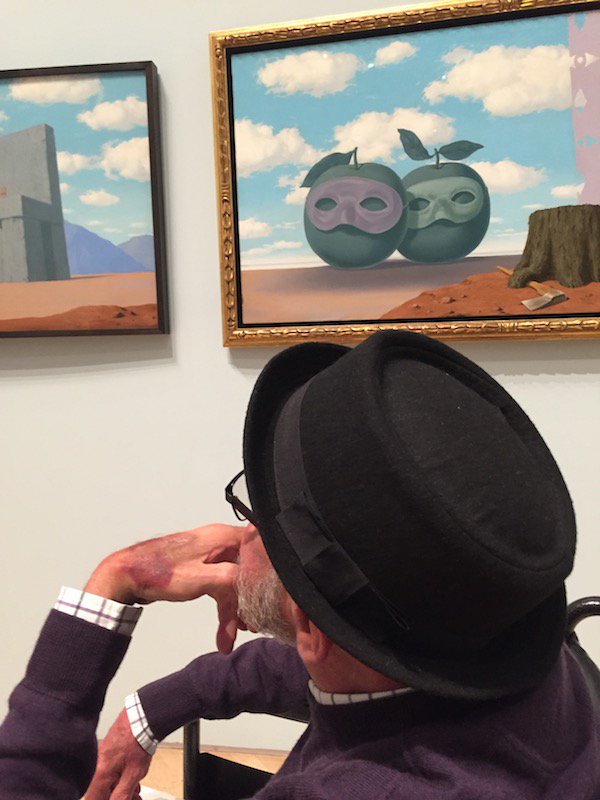This article was originally published in A&U Magazine.
Around the first of April of this year, I began using a wheelchair when I leave the apartment. This was an inevitability that I resisted, fought off for as long as I could. Admitting that I need a wheelchair struck me as “the last straw,” akin to simply giving up, accepting the fact that the virus is winning. Worse, I have become more of a burden to my fiancé Rick than a companion. (When he read a draft of this column, Rick balked at my thinking I’m a burden on him and assured me that I’m not. He’s a good man that way.)
However, between the debilitating pain in my back—from severe osteoporosis, three herniated discs, four compression fractures, and a mysterious inflammation that won’t go away; the loss of muscle mass in my legs; and asthma and COPD—I have no choice. Use the wheelchair or spend the rest of my life hermetically sealed in our apartment.

The author at SFMOMA. Photo by Chael Needle.
The wheelchair also represents a 180-degree turn in my relationship with other long-term HIV survivors and other friends. Like most of us, I have made myself available to friends in need since the early 1980s. That’s nothing special or unique about me—every long-term survivor I know has dedicated innumerable hours to helping others, and continues to do so. And so it’s quite a shift for me, from being one of the go-to guys that many people have relied upon for help, to being the one who <needs> the help. That is extremely uncomfortable for me. I have always feared becoming dependent upon other people. And although Rick and my survivor friends here have been truly angelic about helping me—and assuring me that it’s not burdensome—it still causes me great pain to have to ask for help.
Perhaps second in intensity only to my fear of losing my mind to HIV-related dementia, I have feared this loss of mobility.
But I must admit, I do get a kick out of all the “But ya are, Blanche! Ya are!” quips the chair elicits!
If I’ve learned nothing else during the twenty-nine years since I was diagnosed with HIV, I’ve learned that getting from day to day often entails a major effort to get used to the “new normal” and making the best of it—taking meds every day for ever; quarterly blood draws and evaluation; battling opportunistic infections and ailments; etc. So as I acclimate to this “new normal” in a wheelchair, here’s what I’ve learned to make the best of from the view down here.
The first thing I noticed is that our sidewalks here in San Francisco are barely passable! Many sections of the sidewalks have buckled (from tree roots and earthquakes), leaving a gap as big as a half-inch or more. Bumping over those gaps in the sidewalks can, and often does, jar us wheelchair users like a sledgehammer to the base of the spine. And no amount of caution can ensure missing all of those gaps. They can turn a pleasant Sunday afternoon’s excursion into a torture session.
On a much more pleasant note, however, flowers are at nose level down here! One of the things I’ve always loved about San Francisco is the abundance of naturally blooming flowers during every season, even the “dead of winter.” Flowers that I might have overlooked—literally, looked over—from a standing viewpoint now grab my nose’s grateful attention. Often, as Rick is pushing me around town, I can reach out and brush my hand through the flowers, enjoying their fragrance from much closer than when I walked.
And babies! When I’m cruising along in the chair and someone approaches pushing a baby stroller, I love making eye contact with the child and waving. Most of the time, the baby looks startled, confused—I may be ascribing to them more intelligence than possible for infants and toddlers, but I swear sometimes the baby’s expression seems to say <Why is that baby so big?!> And even if assigning babies that level of cognition is a bit of a stretch, the babies still seem delighted to be greeting someone at eye level. This often makes the stroller pusher laugh also.
That friendliness may be the biggest difference I’ve noticed from down here. People are much friendlier toward us wheelchair users than toward other pedestrians. In this city where people seem to be afraid to make eye contact, or smile, or utter a nonchalant greeting to passersby, the wheelchair seems to draw people’s “better angels” out of them—they smile at me, make eye contact, say “Hi” or “How are you doing?” If I’m maneuvering the chair by myself, they often offer to push the chair for me. I like to think that maybe it’s their way of brightening the day for someone in worse shape than they. In any case, their smiles and greetings and offers of help are most welcome.
So the view from down here isn’t quite so bleak as I had feared all those years. It ain’t no picnic in the park, but it’s not quite so horrible as I anticipated. Just as I and tens of thousands of long-term HIV survivors have done since the day of our diagnoses, I will acclimate to this “new normal.” I will touch and smell the flowers along the way, I will smile and wave at puzzled babies, I will thank strangers for their offers of help. I will roll along with the bumps and not complain.
If you run into me when I’m out and about, and you really want to make my day, just give me your best Baby Jane Hudson impression! I’ll even set it up for you—
“You wouldn’t treat me like this if I weren’t in a wheelchair, Jane…”
The opinions expressed in this article are those of the author and do not necessarily reflect those of the Diverse Elders Coalition.

